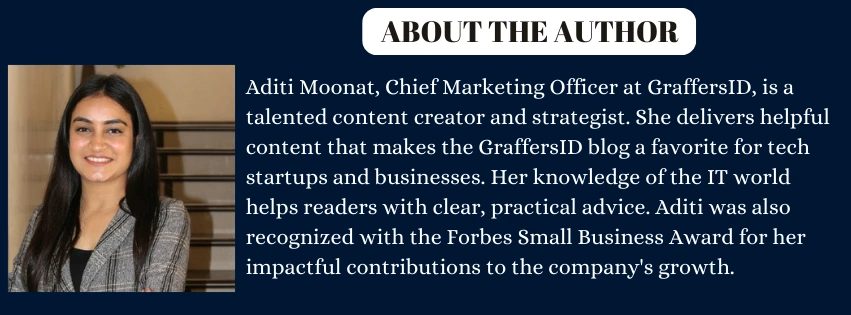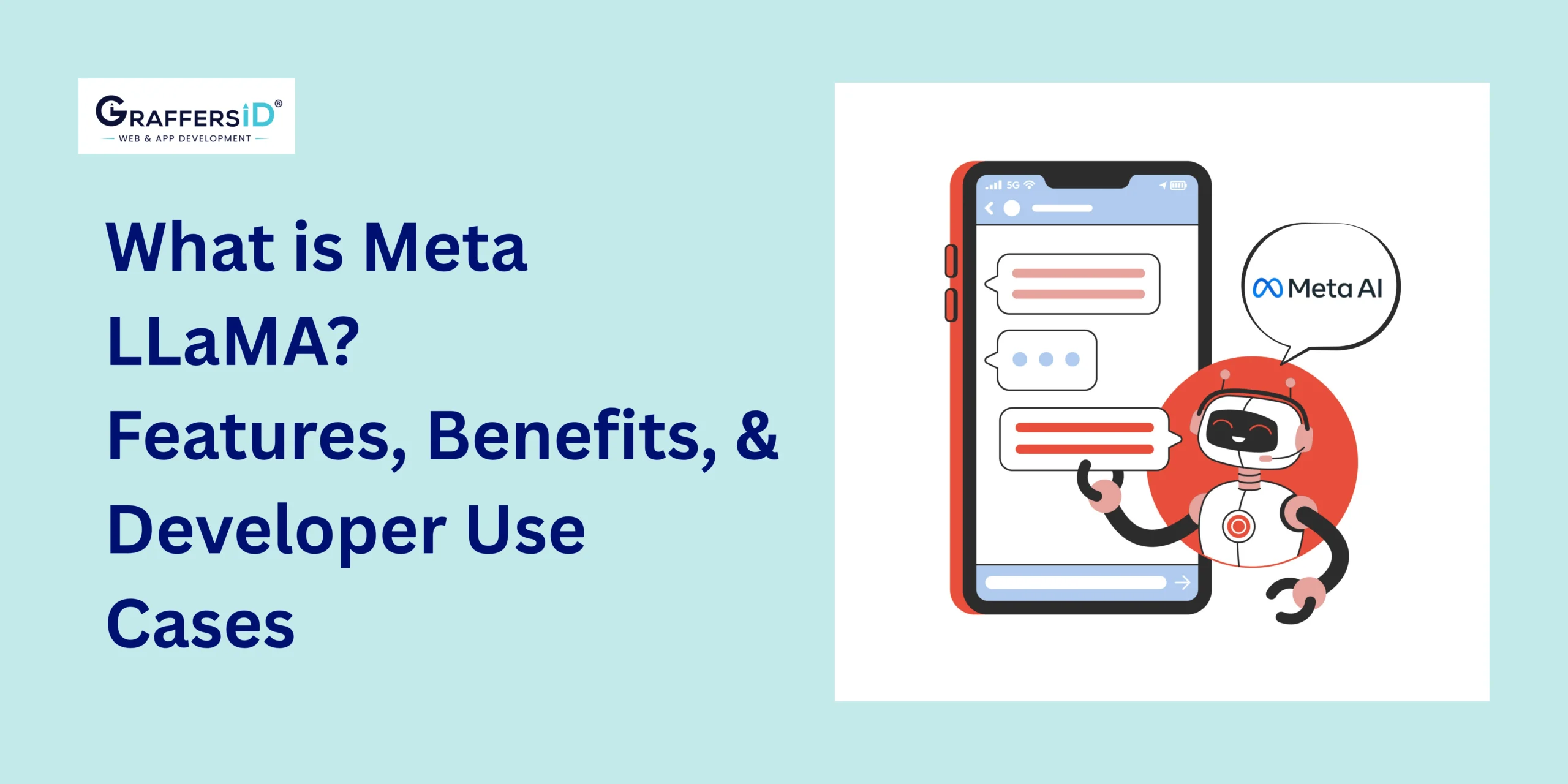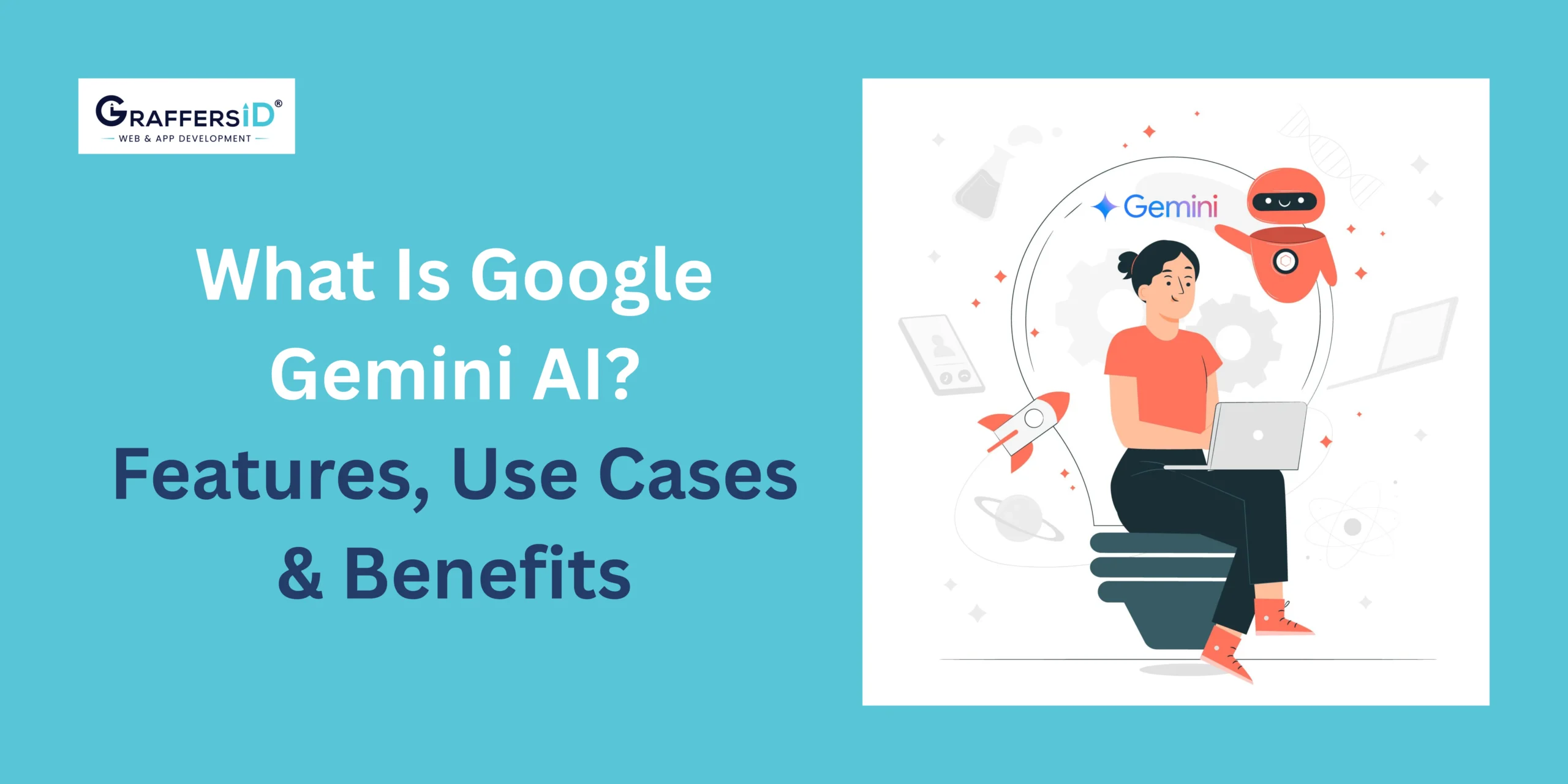Choosing the appropriate tech stack is essential for creating scalable, effective, and high-performance web applications in the constantly changing digital ecosystem of today. However, with numerous options, selecting a technology can be challenging. One of the most popular technologies on the market currently is the MERN stack.
We’ll look at the MERN stack’s definition, why developers and business owners choose it, its benefits and drawbacks, and its ideal applications in this blog.
What is the MERN Stack?
MERN is a popular full-stack development framework, which includes:
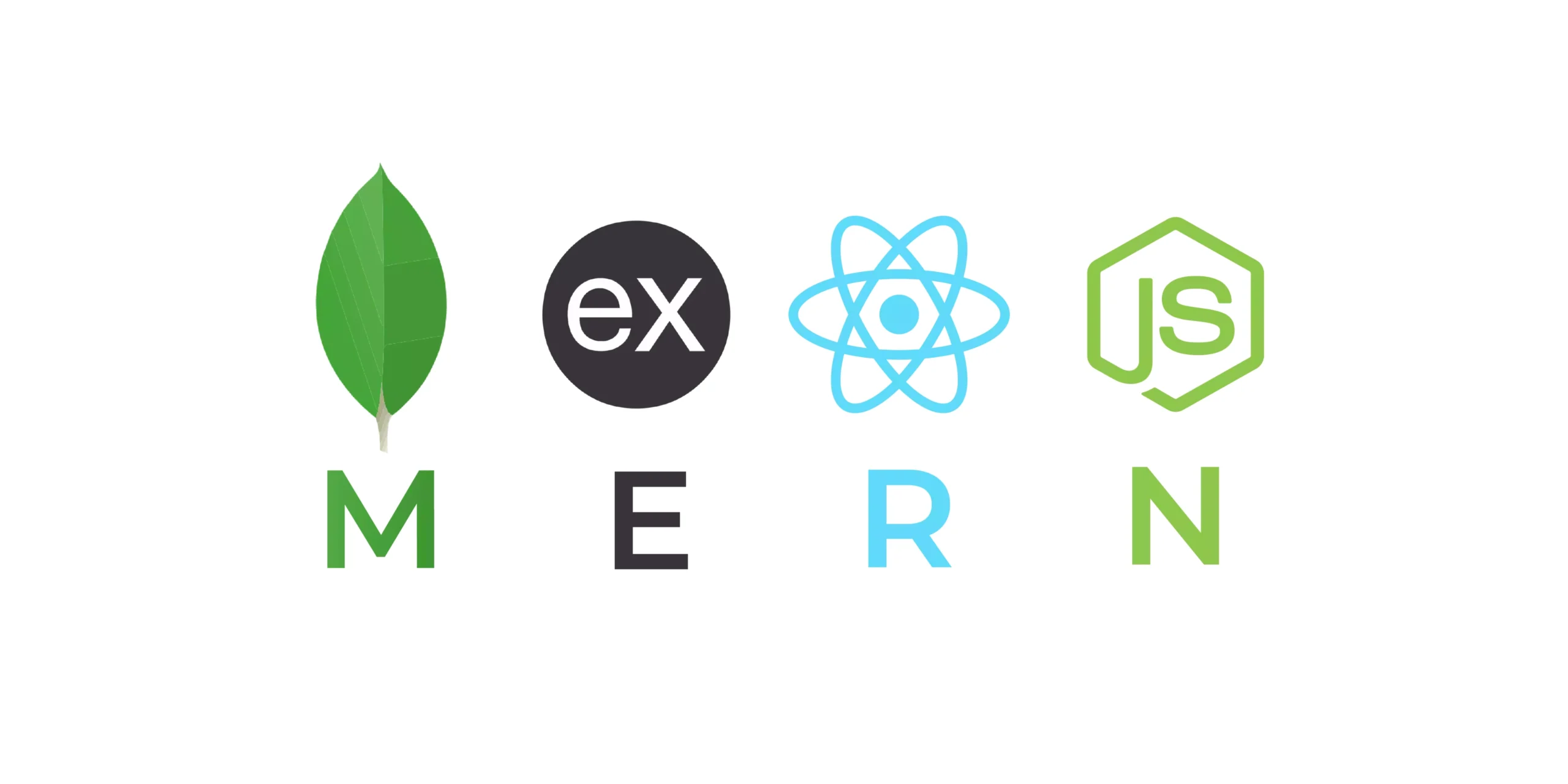
-
MongoDB: A NoSQL database that stores data in flexible JSON-like documents.
-
Express.js: A lightweight backend web application framework running on Node.js.
-
React.js: A JavaScript library developed by Facebook for building rich and interactive UIs.
-
Node.js: A runtime environment that executes JavaScript code on the server side.
Together, all components of the stack allow developers to create full-stack web applications using just JavaScript, from frontend to backend to database communication. This consistency allows for faster, simpler, and more effective development, perfect for startups and agile teams.
Core Components of MERN Stack

1. MongoDB
MongoDB stores data in a flexible, JSON-like format (BSON). It integrates easily with Node.js using the Mongoose library and supports high scalability and performance.
2. Express JS
Express.js is a server-side application framework that encapsulates HTTP requests and responses and makes it easier to map URLs to server-side processes. The HTTP module is removed from a web framework for Node.js with a simple structure.
3. React JS
React builds the user interface with reusable components and a virtual DOM for fast rendering. It communicates with the backend via APIs and renders data dynamically.
4. Node.js
Node.js is a JavaScript runtime environment. The V8 JavaScript engine in Chrome powers the asynchronous language used by the MERN component. With a productive backend, you can speed up the development of web apps while increasing loading times.
Read More: MEAN Stack vs. MERN Stack: Which is Better Technology Stack?
MERN Stack Architecture Breakdown
Let’s see how the MERN components function in a standard architecture:
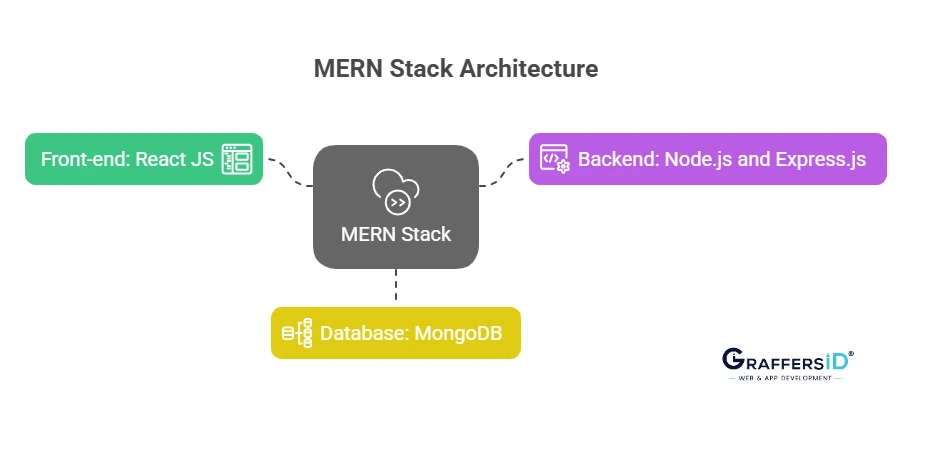
1. Front-end: React JS
The top tier of the MERN stack is React JS, a JavaScript framework for developing client-side HTML applications. Complex interfaces that link to data on a backend server and output as HTML can be made using simple elements.
React is solid and impulsive, managing data-driven interfaces with less code, an advantage of the MERN stack. It supports forms, lists, events, and error handling in one place.
2. Backend: Node.js and Express.js
A vital benefit of the MERN stack is the server-side framework Express JS, which runs on a Node JS server. Express JS is a speedy, unbiased, and lightweight Node JS web framework. It has modules that enable matching an incoming URL with a server management that can deal with HTTP requests and responses.
To connect to Express JS functions that enhance your application, you can utilize XML HTTP requests or React JS front-end POSTs. The functions use Node.js drivers for MongoDB to read and update data in your MongoDB database.
3. Database: MongoDB
One of its benefits is the MERN stack’s ability to store data for content, user profiles, uploads, events, and comments. The ideal situation would be for a database to work seamlessly with Node, Express, and React.
React JS generates the JSON files on the front end, which are then sent to the Express JS server for processing and instant archival in MongoDB for recovery. You can get a lot out of the MERN stack by creating a web application that depends on the system’s functional requirements.
Data Flow:
React sends requests → Express routes the request → Node.js executes logic → MongoDB stores or retrieves data → Response flows back to React.
Benefits of Using MERN Stack in 2025
There are many benefits related to the MERN stack. Some of the most important benefits of creating web applications using the MERN stack are as follows:
1. Full-Stack JavaScript: MERN allows end-to-end development using JavaScript alone. This ensures:
-
A consistent development experience
-
Easier communication between the frontend and the backend
-
Faster onboarding for developers
2. Fast and Scalable: Node.js’s non-blocking architecture can support several concurrent queries. MongoDB’s sharding and horizontal scaling make it excellent for huge data and high-traffic applications.
3. Reusable UI Components with React: React allows for modular development and faster updates. Virtual DOM ensures high performance. Its component reusability saves time during large-scale development.
4. JSON-Based Data Exchange: MongoDB and Express use JSON, aligning with React and Node. This simplifies data manipulation and API development.
5. Strong Community and Ecosystem: The MERN stack offers massive support on GitHub, Stack Overflow, and Discord communities. A vast pool of MERN developers is available for hiring. An abundance of learning resources and third-party plugins are available.
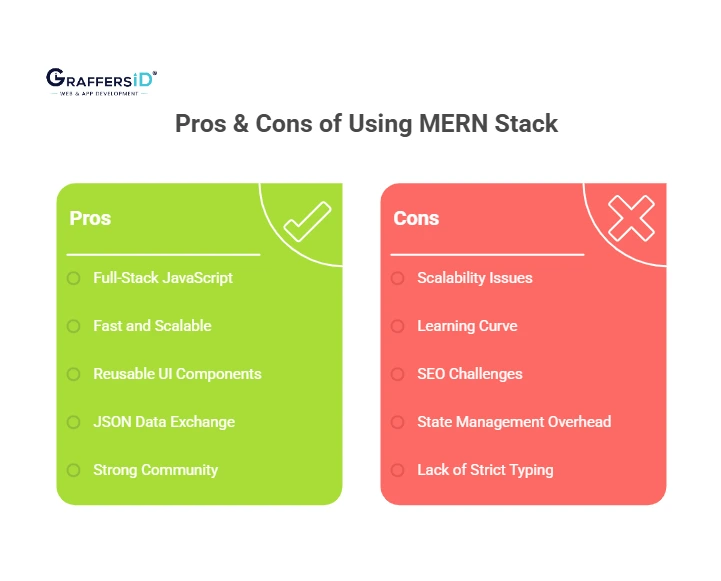
Limitations of the MERN Stack
Even with all of its benefits, the MERN stack has some drawbacks that need to be taken into account before using it for a project:
1. Scalability Issues: Although the MERN stack can efficiently manage medium- to large-scale applications, large and enterprise-grade systems may have difficulties with performance optimization, particularly on the backend (Node.js) for CPU-intensive operations and on the frontend (React) because of frequent re-renders.
2. Learning Curve for Beginners: Even though MERN only uses JavaScript, each component has a learning curve of its own. Learning React‘s JSX, Node.js’ asynchronous programming skills, Express middleware, and MongoDB’s NoSQL structure all at once can be confusing for beginners.
3. SEO Challenges: It can be challenging to optimize React-based single-page applications (SPAs) for search engines unless you use server-side rendering (SSR) or static site generation (SSG) techniques like Next.js. Web spiders might not correctly index content without these.
4. Overhead of Managing State in React: It can be difficult to manage state in React for complex apps, especially when you don’t have tools like Zustand, Redux, or Context API. This might result in spaghetti code or performance issues.
5. Lack of Strict Typing: MERN depends largely on JavaScript, which is a dynamically typed language. As compared to statically typed languages like Java or TypeScript, this allows for more flexibility and speed in development, but it can also result in runtime problems that are more difficult to debug. Large-scale applications with complex data flows may be impacted by this.
When Should You Choose MERN Stack?
The MERN stack is not a generically applicable solution. It is best suited for certain use cases and should be selected when these benefits match your project’s requirements. Here’s when you should consider using MERN:

1. When you need rapid development with a unified language:
MERN is the best option if you want to reduce context switching between frontend and backend development. JavaScript powers all layers, simplifying hiring, debugging, and development.
2. When you need a high-performance, real-time application:
The event-driven, non-blocking I/O of Node.js makes MERN appropriate for real-time applications like live dashboards, messaging applications, and collaboration tools.
3. When flexibility and customization are important:
MERN provides flexibility in selecting folder hierarchies, third-party tools, and organization, as compared to rigid frameworks. MERN is a good choice if your project requires custom architecture.
4. When working with agile and lean teams:
MERN’s fast iteration cycles and component-driven architecture are highly beneficial for small to medium teams. It allows for low-cost MVP launches and quick prototyping.
Read More: Future Of MERN Stack Development
Real-World Use Cases of MERN Stack
Here are some examples of products and use cases where MERN has excelled:
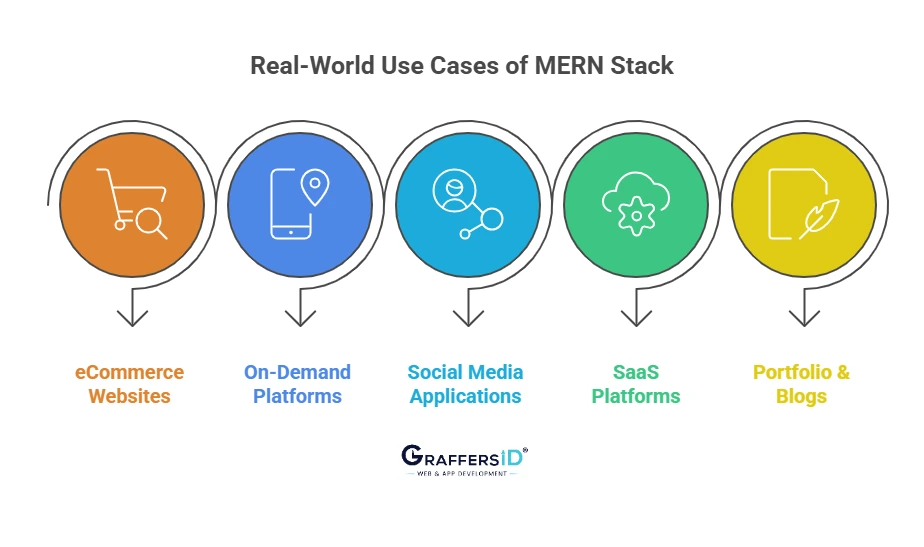
1. eCommerce Websites: Users can build intuitive e-commerce websites using the MERN stack. React delivers a smooth user experience and product filtering. Node handles real-time cart updates and checkout. MongoDB stores product listings, user details, and transactions.
2. On-Demand Platforms (e.g., food delivery, rental apps): MERN handles real-time data flow, geolocation, and live order tracking. Scales smoothly with user base growth.
3. Social Media Applications: Real-time chat, likes, comments, and notifications are easily built with React + Node + MongoDB.
4. SaaS Platforms: Build MVPs quickly for testing. Use React for dashboards, analytics, and complex UI components.
5. Portfolio Websites and Blogging Platforms: Lightweight, SEO-friendly apps that are fast and scalable.
Conclusion
For modern developers and companies, the MERN Stack continues to be an attractive option in 2025. It is an excellent choice for building everything from MVPs to fully scaled platforms due to its all-JavaScript architecture, rapid development potential, and robust performance.
MERN is the go-to stack for project managers, CTOs, and startup founders who are unsure of how to effectively launch their product.
👉 Need help building with MERN?
GraffersID can provide skilled MERN developers to help you accelerate your journey from idea to product, on time and on budget.
Contact Us Now!


